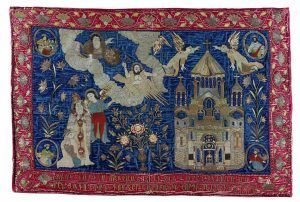Robert Rubsam at Commonweal:
 The Met’s permanent collection can tell you much about the Greeks and Romans, the Babylonians and the Assyrians, medieval Japan and the many dynasties of China, but it does not have as much to say about more marginal peoples. History, here, gathers at the center. If one wants to see peripheries, one must look for them. Wandering the galleries, one rarely get a sense of the vast mosaic of peoples who lived within and often long past those great empires of stone, paper, and capital. The presence of so many Armenian works, directly beside sculpture from Pergamon and Rome, offers an alternative view of history, one in which time eventually pulls down the mighty from their thrones and sometimes lifts up the lowly. The margins come into focus.
The Met’s permanent collection can tell you much about the Greeks and Romans, the Babylonians and the Assyrians, medieval Japan and the many dynasties of China, but it does not have as much to say about more marginal peoples. History, here, gathers at the center. If one wants to see peripheries, one must look for them. Wandering the galleries, one rarely get a sense of the vast mosaic of peoples who lived within and often long past those great empires of stone, paper, and capital. The presence of so many Armenian works, directly beside sculpture from Pergamon and Rome, offers an alternative view of history, one in which time eventually pulls down the mighty from their thrones and sometimes lifts up the lowly. The margins come into focus.
A massive 4’x12’ paper map, commissioned in 1691 for the Venetian ambassador to Constantinople, attempts to chart the Armenian world in tempera and ink. Rather than focusing on the limits of the Ottoman Empire, the Tabula Choreographica Armenica maps churches, overlaying geography with religion and history, including, in this ostensibly modern depiction, a mad St. Gregory smashing demonic idols in the fourth century.
more here.
